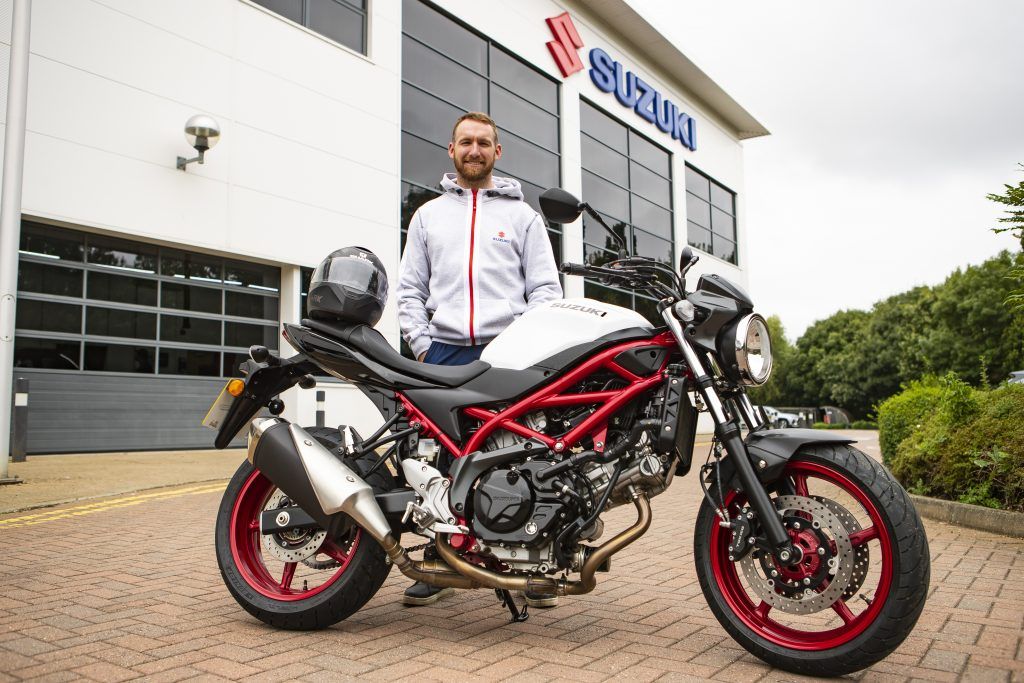| | Biker News - Regularly updated
Category: Random
-
Tokyo Olympic medalist Declan Brooks visited Suzuki GB last week to meet the team, show off his medal, and collect his new SV650. 
Brooks claimed bronze in the freestyle BMX at the 2020 Olympics, the first time the sport has been included in the Games, but when not performing backflips and bar spins in mid-air the 25-year-old can often be found swapping pedal power for horsepower.
After passing his test in 2019 but being confined to an A2 licence, Brooks was finally able to graduate to a full A licence earlier this summer, and last week arrived at Suzuki’s UK headquarters to swap his restricted SV650X for a full power SV650.
While on site, the Team GB athlete was warmly welcomed by Suzuki’s motorcycle division, and spent the morning recounting tales from the Olympic Games while posing for photos with the team.
He said afterwards, “It was great to get up to see everyone at Suzuki and to pick up the new bike. They laid on a bit of breakfast, which was nice, and it was good to chat about BMXing, the Olympics, and just talk bikes. I don’t think it matters if it has an engine or not, if you’re into two wheels then you can get into any type of bike sport, and they spent a lot of time asking about BMX, the sport, and how we do what we do.
“It was good to swap to the full power SV as well. I’ve had to spend a couple of years on the restricted one but obviously rode the unrestricted version for my test, and we went out for a bit of a ride after I’d picked it up as well. I definitely think I’m going to like having a bit more power and I’m looking forward to getting some miles in before the end of the summer.”
Suzuki GB head of motorcycle marketing, Ian Bland, added, “It’s not every day you get to hold an Olympic medal, so we’re very grateful for Declan for coming in and meeting the team and sharing his experiences. It’s an incredible achievement and one he should be proud of. It’s also great to see he enjoys bikes with an engine in the middle as well as pedals, and has now passed his test and is embarking on his own motorcycle journey.”

www.facebook.com/SuzukiBikesUK
-
A fabulous Moto Guzzi owned by Sammy Miller was one of three bikes that scooped top honours at this year’s Salon Privé Concours d’Elégance presented by Aviva. Recognised as the most prestigious such event in the UK, Salon Privé takes place in the magnificent grounds of Blenheim Palace and is a partner concours of The Peninsula Classic Best of the Best Award. It’s renowned for featuring some of the most beautiful and coveted cars and motorcycles from around the world.
This year’s two motorcycle classes spanned nearly 75 years, from a 1901 Triumph 3/4 hp Minerva to a 1975 MV Agusta 750 Sport. Each was assessed by a hugely knowledgeable judging panel comprising broadcaster Henry Cole, historians Dennis Frost and Mike Jackson, former racer Steve Parrish and Chief Judge Nigel Matthews. Judging took place on Wednesday 1 September, with all trophies being awarded on Thursday 2 September.
It was championship-winning racer Sammy Miller who scooped top honours in the Competition Motorcycle Class with a 1951 Moto Guzzi Bicilindrica 500cc V Twin. Judge Steve Parrish said: “The Moto Guzzi Bicilindrica 500cc V Twin had the longest career of any motorcycle racing bike ever. Actually, Ducati in some ways copied the engine configuration to make the successful racing Ducatis that we see nowadays. It was way ahead of its time in terms of technology. The bike was raced by the great Bob Foster and Stanley Woods and put in some incredible performances both on road and track, claiming victories at the Isle of Man TT and Grand Prix. The judges all agreed that it’s a very special motorbike and a real beauty.”
Second place in the Competition Motorcycle Class went to a 1973 Yamaha TZ 250 A, entered by the Sawford family, owners of St Neots Motorcycles. The family are experts in restoring two-stroke motorcycles from the 1970s and 1980s. Parrish continued: “The motorcycle is better than when it came out of the factory – absolutely original and exquisitely put together. It had to be in the top two, what with its authenticity and how it’s been built – stunning. We were also delighted to be joined by 1970 250cc World Champion Rodney Gould, who was instrumental in the production and development of the bike.”
Topping the Exceptional Motorcycles class was a 1975 MV Agusta 750 Sport, often referred to as the most beautiful bike to come out of Italy and revered as an icon of the 1970s. An original and beautiful machine, the winning example is one of the last three to come out of the factory and features a rare left-hand gearchange.

Second place was awarded to a 1973 Rickman-Metisse Cafe Racer. Judge Henry Cole said: “It’s wonderful to see several Metisses here paying homage to its founder Derek Rickman, a consummate biking enthusiast and a legend in my eyes who passed away recently. What a great way to celebrate his life. The Café Racer in this class is a beautifully customised, really genuine yet individual bike that has been put together with a huge amount of love and passion, and to the judges that’s what we’re after.”
The Duke of Marlborough Award was presented to the 1901 Triumph ¾hp Minerva. Steve Parrish said: “This is the very first Triumph motor bicycle ever made – the forerunner of all subsequent Triumphs. As in everything Dick Shepherd does, it’s been lovingly restored, and he’s put together a motorcycle that would be befitting of it coming out of the factory in 1901. I suspect it’s even better!”
Henry Cole added: “It’s quite a find for Triumph to have in their 125th anniversary year and one that we had to honour.”
Alongside the concours entrants was multiple Salon Privé award winner and renowned motorcycle builder Allen Millyard displaying his beautifully engineered Kawasaki Z1 Super Six. Elsewhere on the lawns of Blenheim Palace, there was the debut of Thornton Hundred Motorcycles, one of the world’s fastest-growing custom motorcycle brands. The British company’s line-up included the ‘World’s Fastest Bobber’ – a 202bhp technological tour de force – and a 2021 Triumph Bonneville Bobber Black, both were a Salon Privé debut.
“All of our motorcycles exude individuality and exclusivity,” said Jody Millhouse, the man behind Thornton Hundred and part of a new wave of engineers who are at the cutting edge of the custom scene. “We want to give owners a unique modification experience, and those values align perfectly with Salon Privé. It’s great to be here showing off our latest designs against the amazing backdrop of Blenheim Palace.”
Italian exotica brand Bimota made its UK public debut with the Tesi H2. The limited-production, supercharged Bimota Tesi H2 is built around a Kawasaki Ninja H2 powerplant and features the famous Bimota hub-centre steering system, while the chassis is covered with carbon fibre bodywork. Power output is a staggering 242hp (178kW).
Crazy Horse made a welcome return to Salon Privé showcasing a superb collection of its customised Indian Motorcycles, including the KH Street Hooligan. The Hooligan shares the great styling of its racing relative, but is fitted with all the relevant components to make it a fully functional street machine without losing any of its iconic flat-track racing looks.
-
More stringent CO2 targets go hand in hand with concrete measures and concepts for implementation
The BMW Group is putting circular economy and sustainable urban mobility at the centre of its presence at the 2021 IAA Mobility. At the motor show, the company is consistently demonstrating its sustainability and CO2 targets as well as its concrete measures and concepts to achieve these goals.
-
Bicycling is a great way to get some workouts, enjoy the views, and lower your carbon impact. Bike riders, on the other hand, confront a slew of dangers. Even on a designated path, they still frequently share space with automobiles, and accidents can occur anytime. So, you need to be careful and follow basic bike riding safety tips for your benefit and overall wellness.
What Are the Topmost Bike Riding Safety Tips?
Bicycling is a fantastic way to be autonomous while having fun. It's vital to keep in mind, though, that a bike is not a joke. It's a vehicle, after all. So, when you're riding, keep your calm and observe some simple safety precautions. Being safe is of the utmost importance in every walk of life.
Wear A Helmet
Putting on a helmet is the first step in each bike trip. Nevertheless, it's also critical that you get the right fit. This is the greatest way for your headgear to cover you. Everybody, particularly adults and children, should wear a bicycle helmet on every bicycle ride, irrespective of the duration of the journey. You must ensure that the helmet is approved and capable of protecting you in the event of an accident. As a result, avoid low-cost alternatives and go for approved helmets. They may be more expensive, but they will save your life.
Dress in Bright Colors
You need to be noticed by other drivers even if it's afternoon, dawn, twilight, adverse weather, or nighttime. It has not been proven that wearing white makes you more noticeable. Instead, while biking at night or during the day, constantly wear vibrant, fluorescent, or other bold colors. Use reflective material or symbols, as well as blinking lights or something that emits light. It's important to remember that just because you can see a motorist doesn't indicate that the driver can see you too. So, try to wear brighter colors to be seen and avoid accidents.
Watch Out for Hazards
You need to constantly watch out for road hazards. Speed bumps, glass shards, pebbles, pools, twigs, and dogs are all potential risks. All of these dangers have the potential to cause a collision. If you're biking with pals, scream out and point to the danger to notify the bikers behind you. This way, you can easily shield yourself and others from road hazards.
Stay Focused
Keep your eyes on the road and all other vehicles around you. You must foresee what others will do before they even do it. This is proactive riding, and the sooner you detect a particular risk, the sooner you can take action to avoid a collision. You must follow the flow of traffic and move in the same way as it does. Follow the same rules as an automobile when it comes to road markings, indicators, and speed limits. You must also presume that the other party is not aware of your presence. So, keep an eye out for risks or scenarios to avoid, such as objects, stones, potholes, grates and railroad tracks.
article supplied
-
72.2% of drivers consider changing their vehicle as ULEZ expansion looms
Bikesure; the specialist motorbike insurance broker’s recent survey of Londoners found that a majority will change the way they travel when the Ultra Low Emission Zone (ULEZ) expansion takes place later this year. With motorbike sales recovering in the UK, (in May 2021 sales are up 40.3% vs the 2020*) it is no surprise that 84% of people will continue to ride in the ULEZ following its expansion in October 2021.
Bikesure have published their ULEZ 2021 Report tracking opinion change over three consecutive years towards the ULEZ and the alternative modes of transport favoured by commuters. This year 18.6% are set to choose two wheels over four with 9.3% of them favouring an eclectic or low-emission motorbike, moped or scooter over any other vehicle type.
Londoners to go green on two wheels
Although a majority of Londoners will continue to ride in the ULEZ following its expansion, commuters are giving new consideration to the benefits of switching to EVs. The ULEZ expansion has accelerated a majority of Londoners' intentions to buy an EV (73.4%) as those who join the green transport revolution can anticipate lower running costs as well as making a positive impact on the environment. Encouragingly, only 13.5% of people are planning to stick with petrol vehicles.
Those set to switch to greener alternatives such as an EV or an electric scooter or motorbike can anticipate saving on the £12.50 daily charge for older and more polluting vehicles (up to 3.5 tonnes) that continue to drive within the newly expanded ultra low emission zone.
ULEZ vs. CAZ’s
While sentiments remain positive about the impact of the ULEZ, with its expansion looming, commuter approvals have slightly decreased as almost 4 million people are set to be impacted. This year, 40.3% of respondents felt it was a good idea, compared to 44.9% in 2020.
There has also been a decrease in the amount of people who understood the reasons behind the ULEZ expansion, but couldn’t help but feel frustrated by it. This year, 37.5% approve of the ULEZ expansion but are frustrated by its impact on their lives, down on 43.2% surveyed in 2020.
Encouragingly, 37.4% feel the introduction of Clean Air Zones across several major UK cities is a positive thing for the country. While some scepticism remains, the verdicts are very similar, with again the vast majority (66.1%) hold positive sentiment for the introduction of CAZs.
“After a tough start to the year for the motorcycle industry, it is encouraging to see a positive increase in those not just considering switching their form of transport to motorbikes, but also considering electric alternatives” says Rob Balls, Underwriting Manager at Bikesure.
Read Bikesure’s ULEZ 2021 report here
These findings were sourced from a survey of 1,000 nat rep from 14 - 21 June 2021.
article supplied
|






